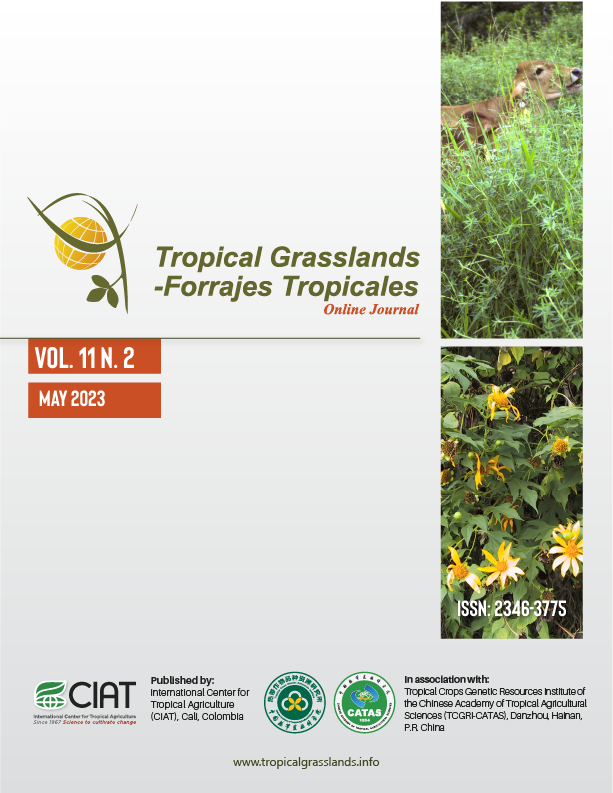Influence of shade on productivity and nutritional value of Urochloa decumbens in silvopastoral systems using different spatial arrangements of eucalyptus cultivars
DOI:
https://doi.org/10.17138/tgft(11)169-182Abstract
This study evaluated pasture productivity and nutritional characteristics of Urochloa decumbens in silvopastoral systems (SPS) with different eucalyptus cultivars and spatial arrangements providing differing levels of shade. SPS were arranged to provide 46 % shade (eucalyptus trees arranged in 2 double rows 2 m apart, with trees every 3 m in each row, and 20 m between double rows), 60 % shade (eucalyptus trees arranged in 2 double rows 2 m apart, with trees every 2 m in each row in double rows and 9 m between double rows) and 57 % shade (eucalyptus trees arranged in a single row, with trees every 2 m in the row and 9 m between rows) using eucalyptus cultivars ‘GG100’, ‘I144’ or ‘VM58’. Two full sun pastures treated as managed (soil pH correction and N, P and K fertilizer application) or non-managed (no correction or fertilizer application) were evaluated in addition to the 3 SPS arrangements. Photosynthetically active radiation (PAR) was 1,439 μmol/m2/s in full sun compared with a mean of 715 μmol/m2/s under different SPS arrangements. Leaf area index of U. decumbens was 28 % higher in 46 % shade and lower in all shade arrangements compared with full sun managed pasture. The dry matter yield was 58 % lower in 46 % shade and 86 % lower in 60 % shade compared with full sun managed pasture. The crude protein content in SPS pastures was higher than in the full sun pastures, with higher values in 57 % and 60 % shade. SPS significantly reduced the PAR and forage yield. These results indicate that in systems where the main objective is animal production, spacing between tree rows greater than 20 m should be used to provide sufficient high-quality grass.
Author Biography
Alan Figueiredo de Oliveira, Universidade Federal de Minas Gerais, Escola de Veterinária, Belo Horizonte, MG, Brazil.
Animal Science Department
References
Alvares CA; Stape JL; Sentelhas PC; Gonçalves JLM; Sparovek G. 2013. Köppen's climate classification map for Brazil. Meteorologische Zeitschrift 22(6):711–728. doi: 10.1127/0941-2948/2013/0507
AOAC. 1995. Official methods of analysis. AOAC International, Arlington, USA.
Bjorkman O; Berry J. 1973. High-efficiency photosynthesis. Scientific American 229(4):80–93. bit.ly/45de3bt
Chatterjee N; Nair PR; Chakraborty S; Nair VD. 2018. Changes in soil carbon stocks across the Forest-Agroforest-Agriculture/Pasture continuum in various agroecological regions: a meta-analysis. Agriculture, Ecosystems and Environment 266:55–67. doi: 10.1016/j.agee.2018.07.014
Deinum B; Sulastri RD; Zeinab MHJ; Maassen A. 1996. Effects of light intensity on growth, anatomy and forage quality of two tropical grasses (Brachiaria brizantha and Panicum maximum var. trichoglume). Netherlands Journal of Agricultural Science 44(2):111–124. doi: 10.18174/njas.v44i2.551
Dias-Filho MB. 2014. Diagnóstico das Pastagens no Brasil. Documentos 402. Embrapa Amazônia Oriental, Belém, PA, Brazil. bit.ly/42MYPYS
Geremia EV; Crestani S; Mascheroni JDC; Carnevalli RA; Mourão GB; Silva SC da. 2018. Sward structure and herbage intake of Brachiaria brizantha cv. Piatã in a crop-livestock-forestry integration area. Livestock Science 212(June):83–92. doi: 10.1016/j.livsci.2018.03.020
Giro A; Pezzopane JRM; Junior WB; Pedroso AF; Lemes AP; Botta D; Romanello N; Barreto AN; Garcia AR. 2019. Behavior and body surface temperature of beef cattle in integrated crop-livestock systems with or without tree shading. Science of Total Environment 684:587–596. doi: 10.1016/j.scitotenv.2019.05.377
Gomes FJ; Pedreira BC; Santos PM; Bosi C; Pedreira CGS. 2020. Shading effects on canopy and tillering characteristics of continuously stocked palisadegrass in a silvopastoral system in the Amazon biome. Grass and Forage Science 75(3):279–290. doi: 10.1111/gfs.12478
Gómez S; Guenni O; de Guenni BL. 2012. Growth, leaf photosynthesis and canopy light use efficiency under differing irradiance and soil N supplies in the forage grass Brachiaria decumbens Stapf. Grass and Forage Science 68(3):395–407. doi: 10.1111/gfs.12002
Guenni O; Romero E; Guedez Y; Guenni LB; Pittermann J. 2018. Influence of low light intensity on growth and biomass allocation, leaf photosynthesis and canopy radiation interception and use in two forage species of Centrosema (DC). Benth. Grass and Forage Science 73(4):967–978. doi: 10.1111/gfs.12368
Lima MA; Paciullo DSC; Silva FF; Morenz MJF; Gomide CAM; Rodrigues RAR; Bretas IL; Chizzotti FHM. 2019. Evaluation of a long-established silvopastoral Brachiaria decumbens system: plant characteristics and feeding value for cattle. Crop and Pasture Science 70(9):814–825. doi: 10.1071/CP19027
Mezzalira JC; Carvalho PCF; Fonseca L; Bremm C; Cangiano C; Gonda HL; Laca EA. 2014. Behavioural mechanisms of intake rate by heifers grazing swards of contrasting structures. Applied Animal Behaviour Science 153(April):1–9. doi: 10.1016/j.applanim.2013.12.014
Müller MD; Nogueira GS; Castro CRT de; Paciullo DSC; Alves FF; Castro RVO; Fernandes EN. 2011. Economic analysis of an agrosilvipastoral system for a mountainous area in Zona da Mata Mineira, Brazil. Pesquisa Agropecuária Brasileira 46(10):1148–1153. doi: 10.1590/S0100-204X2011001000005
Oliveira AF de; Menezes GL; Gonçalves LC; Araújo VE de; Ramirez MA; Júnior RG; Jayme DG; Lana AMQL. 2022. Pasture traits and cattle performance in silvopastoral systems with Eucalyptus and Urochloa: Systematic review and meta-analysis. Livestock Science 262:104973. doi: 10.1016/j.livsci.2022.104973
Oliveira CHR; Reis GG; Reis MGF; Leite HG; Souza FC; Faria RS; Oliveira FB. 2015. Dynamics of eucalypt clones canopy and Brachiaria brizantha production in silvopastoral systems with different spatial arrangements. Agroforestry Systems 90:1077–1088. doi: 10.1007/s10457-015-9884-9
Paciullo DSC; Gomide CAM; Castro CRT; Maurício RM; Fernandes PB; Morenz MJF. 2016. Morphogenesis, biomass and nutritive value of Panicum maximum under different shade levels and fertilizer nitrogen rates. Grass and Forage Science 72(3):590–600. doi: 10.1111/gfs.12264
Paula RR; Reis GG; Reis MGF; Oliveira Neto SO; Leite HG; Melido RCN; Lopes HNS; Souza FS. 2013. Eucalypt growth in monoculture and silvopastoral systems with varied tree initial densities and spatial arrangements. Agroforestry Systems 87:1295–1307. doi: 10.1007/s10457-013-9638-5
Pezzopane JRM; Nicodemo MLF; Bosi C; Garcia AR; Lulu J. 2019. Animal thermal comfort indexes in silvopastoral systems with different tree arrangements. Journal of Thermal Biology 79:103–111. doi: 10.1016/j.jtherbio.2018.12.015
Pontes LS; Barro RS; Savian JV; Berndt A; Moletta JL; Porfirio-da-Silva V; Bayer C; Carvalho PCF. 2018. Performance and methane emissions by beef heifer grazing in temperate pastures and in integrated crop-livestock systems: the effect of shade and nitrogen fertilization. Agriculture, Ecosystems and Environment 253:90–97. doi: 10.1016/j.agee.2017.11.009
R Core Team. 2019. R: A language and environment for statistical computing. R Foundation for Statistical Computing, Vienna, Austria. R-project.org
Santos DC; Júnior RG; Vilela L; Pulrolnik K; Bufon VB; França AFS. 2016. Forage dry mass accumulation and structural characteristics of Piatã grass in silvopastoral systems in the Brazilian savannah. Agriculture, Ecosystems and Environment 233:16–24. doi: 10.1016/j.agee.2016.08.026
Santos DC; Júnior RG; Vilela L; Maciel GA; França AFS. 2018. Implementation of silvopastoral systems in Brazil with Eucalyptus urograndis and Brachiaria brizantha: Productivity of forage and an exploratory test of the animal response. Agriculture, Ecosystems and Environment 266:174–180. doi: 10.1016/j.agee.2018.07.017
Stape JL; Binkley D; Ryan MG; Fonseca S; Loos RA; Takahashi EN; Silva CR; Silva SR; Hakamada RE; Ferreira JMA; Lima AMN; Gava JL; Leite FP; Andrade HB; Alves JM; Silva GGC; Azevedo MR. 2010. The Brazil Eucalyptus Potential Productivity Project: Influence of water, nutrients and stand uniformity on wood production. Forest Ecology and Management 259(9):1684–1694. doi: 10.1016/j.foreco.2010.01.012
Tonucci RG; Nair PKR; Nair VD; Garcia R; Bernardino FS. 2011. Soil carbon storage in silvopasture and related land-use systems in the Brazilian Cerrado. Journal of Environmental Quality 40(3):833–841. doi: 10.2134/jeq2010.0162
Torres CMME; Jacovine LAG; Neto SNO; Fraisse CW; Soares CPB; Neto FC; Ferreira LR; Zanuncio JC; Lemes PG. 2017. Greenhouse gas emissions and carbon sequestration by agroforestry systems in southeastern Brazil. Scientific Reports 7:16738. doi: 10.1038/s41598-017-16821-4
Van Soest PJ. 1994. Nutritional Ecology of the Ruminant. Cornell University Press, Cornell, USA. 476 p.
Van Soest PJ; Robertson JB; Lewis BA. 1991. Methods for dietary fiber, neutral detergent fiber and nonstarch polysaccharides in relation to animal nutrition. Journal of Dairy Science 74(10):3583–3597. doi: 10.3168/jds.S0022-0302(91)78551-2
WRB (World Reference Base for Soil Resources). 2006. A Framework for International Classification, Correlation and Communication. Food and Agriculture Organization of the United Nation, Rome. bit.ly/3WleWdR
How to Cite
Downloads
Downloads
Published
Issue
Section
License
Copyright (c) 2023 Tropical Grasslands-Forrajes Tropicales

This work is licensed under a Creative Commons Attribution 4.0 International License.




